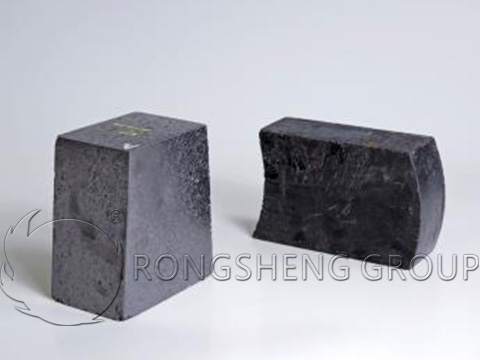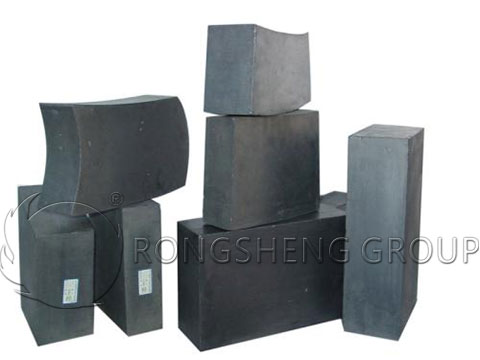Magnesia-carbon bricks are carbon-bonded alkaline bricks that are prepared from magnesia, carbon raw materials, organic binders, and admixtures and are kneaded, high-pressure formed, and treated at low temperatures. This brick takes full advantage of the advantages of alkaline materials and carbon materials, so it has excellent thermal shock resistance, peeling resistance, slag resistance, and high-temperature creep resistance. Magnesia carbon brick is an ideal lining material for metallurgical smelting furnaces and has received great attention from various countries. At present, our country can produce ordinary and high-strength magnesia carbon bricks, as well as functional products such as magnesia carbon breathable bricks, which can basically meet the needs of the development of the metallurgical industry.

Magnesium Carbon Refractory Material Furnace Lining
Magnesia-carbon refractory materials are used as furnace lining refractory materials. They effectively utilize the slag corrosion resistance of magnesia and the high thermal conductivity and low expansion of carbon, compensating for the biggest shortcoming of magnesia’s poor spalling resistance. It mainly has the following excellent properties.
(1) High-temperature resistance.
MgO and C have no eutectic relationship at high temperatures, and their melting points are both relatively high. The melting point of magnesium oxide is 2800°C, and the melting point of carbon is above 3000°C. Therefore, the magnesium-carbon refractory material made by combining the two has a higher melting point and better high-temperature resistance.
(2) Strong resistance to alkaline slag corrosion.
MgO itself has strong resistance to alkaline slag and high-speed iron slag. The wetting angle of graphite to slag is large, and its wetting performance with molten slag is very poor.
(3) Good thermal shock stability.
Among magnesia-carbon refractory materials, graphite has a high thermal conductivity, a low thermal expansion coefficient, and a small elastic modulus. Therefore, the refractory material has good thermal shock stability.
The performance of MgO-C bricks is mainly affected by the main and auxiliary raw materials and chemical composition, the relative content of each component, and the mixture structure. However, the type of binder, processing, and molding techniques also play an equally important role.

Magnesia Carbon Bricks Production Process
Selection of raw materials. The raw materials for producing MgO-C bricks (https://rsrefractoryfirebrick.com/magnesia-carbon-bricks) are mainly magnesia. Its technical requirements are high purity, few impurities, complete particle crystal development, uniform texture, low porosity, and high volume density. Magnesia is divided into fused magnesia and sintered magnesia, but gradually replacing part of the sintered magnesia with fused magnesia can significantly improve corrosion resistance. The carbon raw material generally uses natural flake graphite. It has no eutectic relationship with oxides such as MgO and does not form low-melting materials. It has high thermal conductivity, small elastic modulus, low thermal expansion coefficient, and is non-wetting.
The binder is the key material for the production of MgO-C bricks. Its technical requirements include: (1) The wetting angle for carbon materials is small and the affinity is good. (2) The residual carbon rate is high. (3) Less impurities and moisture content. Commonly used binding agents include phenolic resin, modified phenolic resin, and tar asphalt. Nowadays, most MgO-C bricks are produced using synthetic phenolic resin. Admixtures mainly include unit metals and multi-element metal powders such as Al, Mg, Si, Al-Mg, AI-Si, and Al-Mg-Ca. B4C, Al8BC7, Al4SiC4, and other carbon pure substances and complex alkalized substances. As well as borides such as ZrB2, MgB, CaB6.
Proportion. 5-1(3-1)mm magnesia 50~60%. <1mm magnesia 10%. <0.074mm magnesia+graphite+additive 30~40%. Resin 5% (additional).
Drill. The feeding sequence is generally magnesia particles – binder – graphite – magnesia fine powder and mixed fine powder of additives. It is best to perform it in kneading equipment with a heating device so that the resin has good flow properties and can achieve uniform distribution.
forming. When using a hydraulic press to produce MgO-C bricks, the pressure is generally required to reach 115~200MPa. The number of pressurization times cannot be less than 15 times.
Magnesia carbon brick molding
heat treatment. MgO-C bricks are generally processed at a temperature of 200~250℃. heating system. 50~60℃, because the resin softens, it should be kept warm. 100~110℃, a large amount of solvent will be discharged, so it should be kept warm. 200 or 250℃, to complete the reaction, it should be kept warm.
It is not difficult to see that the production of MgO-C bricks has reached its limit from raw materials to technology. Therefore, the performance improvement of existing MgO-C bricks will be slow and very limited. In addition, resources are limited. Since graphite is easily oxidized, the high-temperature reaction between magnesium chloride and graphite always exists, especially in a vacuum metallurgical environment.
The redox reaction of MgO-C bricks and the redox reaction of oxide inclusions and carbon are determined by the nature of the material. The ease of oxidation of graphite is the dominant aspect that determines this nature. Therefore, artificial modification of graphite is an effective way to solve this problem. Only in this way can the chemical compatibility conditions of MgO-C bricks be further improved, thereby promoting the development of MgO-C bricks.
